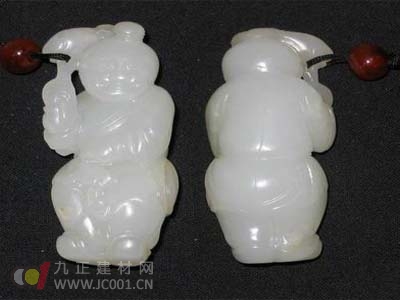The jade of different eras is not exactly the same. To summarize the history of jade development in the past 6800 years, we can look at the value of jade from the following aspects:
First of all, the raw material of the jade, that is, the jade material itself is a gemstone, and thus has its own value, which is the difference between jade and other antiques such as calligraphy and painting, bronze, ceramics and the like. The value of jade material is limited by origin, color, shape, size, and so on.
Although there has been a jade view of "the gentleman examines jade, the virtue is secondary and the second color" in history, the story about Heshi in the pre-Qin period just proves that the value of jade material is valued by people. After the Qin and Han Dynasties, the Western Region and the jade jade poured into the mainland, and they were favored by people for their large output, pure texture and good color. Since then, and Yuyu monopolized China for 2000 years, Qing Emperor Qianlong spent a lot of money and material resources, and transported a single piece of heavy jade from Xinjiang. Yan Yixuan and Tian Yu said that it was not until the middle of the 19th century that the jade that was transported from Myanmar replaced the traditional Chinese jade.
It can be seen from the introduction that the jade material itself has a value that cannot be ignored. Second, the initial jade is mainly production tools, ritual tools and decorations. With the continuous development of production, the wealth of society has gradually increased, the concept of hierarchy has become heavier and heavier, and jade articles with rare production and beautiful appearance have given the concept of such a system. From the middle of the Neolithic Age, some fine jade objects were discovered in the tombs of the clan chiefs.

In the late Neolithic period, this phenomenon became more apparent. In some cemeteries of Liangzhu Culture, there were hundreds of jade articles in a tomb. One of the jade articles that caused the shape was obviously only unearthed in large tombs and became only a few. The ruler has the right to occupy the utensils. In the Shang and Zhou dynasties, the situation was more common. The "handle-shaped ornaments" in the two-headed cultural relics were unearthed in the large tombs of the Shang and Zhou Dynasties. After Qin, Yuxi became a symbol of monarchy.
It is said that after Qin Shihuang unified China, he used a fine Lantian jade (also known as Heshiyu) to make a pass to the country. Later generations of emperors valued this passer-by and thought that they had to get this. It is the true child. Several emperors in the Eastern Jin Dynasty did not get this scorpion, and they were degraded as "white version of the Son of Heaven." The generations after Han also specifically stipulates what kind of person can be qualified to obtain a certain type of jade. The system of jade as a beggar has been inherited from the Qing Dynasty. The vast majority of the 25 treasures determined by the Emperor Qianlong were made of jade. In the Tang Dynasty, strict restrictions were imposed on the use of jade belts, such as the so-called "New Tang Book · Qifu", which was followed by the service of purple as the third product, and the golden jade with the thirteen; , Jindai 銙 eleven...."
In the book "Zhou Li", it has been recorded in detail. The use of "Six Rui" is as follows: the most large-sized town of the gods, the public, the government, the loyalty, the priest, the son and the male glutinous Pampas. People who are not qualified at a certain level are not allowed to wear it. "Zuo Zhuan" clearly stated: "The husband is not guilty and bears his sin." It can be seen that from the end of the primitive society to the Qing Dynasty, some jade articles have always been an important symbol of the political hierarchy.
Jade is also a means of gathering wealth and a sign of wealth. In the Liangzhu culture, more than dozens of jade burial tombs were unearthed. The tomb owners are all those who have the right to have wealth. Some of the tombs were unearthed with hundreds of jade articles. In addition to being used as a sect and a funeral device, they have the function of marking wealth. A large number of jade articles were unearthed in a group of Shang Dynasty aristocrats and Fang Guo’s tombs, such as the Women’s Tomb in Yinxu in Anyang and the Xingan Tomb in Jiangxi. In the Shang Dynasty, there was a coin of jade, that is, a shell-shaped jade coin, and jade was also used as an exchange and tribute. A piece of jade unearthed from the woman’s tomb was engraved with “Luo Fang’s Ge Yuâ€.
In the Ming Dynasty, the jade materials used in the Shangwang room were quite partly from Liaoning and Xinjiang, and were obtained through exchange or tribute. In the Western Zhou Dynasty, the Shu Kingdom, which was located in Sichuan, once contributed to Qiongyu to Yi Wang. The value of the precious jade is worthy of a city. In order to get a piece of fine jade, it is no different from launching a war. After the Qin and Han Dynasties, jade has always been favored by the powerful as a wealthy property. Sold as a commodity, it has been around since the Song Dynasty. Since the Ming and Qing Dynasties, jade shops have gradually increased. Late in the Qing Dynasty, the value of jade was generally higher, and there was a saying that “the old jade of bronze was not pricedâ€.
Precession Vortex Flowmeter,Precession Vortex Flow Meter,Precession Vortex Gas Flow Meter,Hydraulic Flow Meter
Wuxi Winsun Automation Instrument Co., Ltd , https://www.winsunwx.com